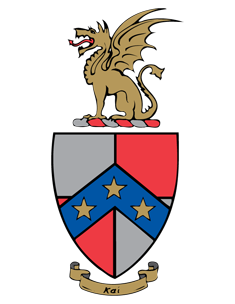Fraternity Heraldry
Our chapter shares in the rich traditions of all of Beta Theta Pi. Our great fraternity has many insignias, all with great importance. Many of these are items that are commonly seen in our chapter house, on our apparel, or on our documents. Here is a brief explanation of some of these insignias.
Flower
Betas who gathered to celebrate the Fraternity’s Semi-Centennial in 1889 were guests of the Western Female Seminary at a reception. Here, roses of the “June” or “Queen of the Prairie” variety, growing on the bush adjacent to the veranda of Peabody Hall, were presented to several Betas including Founders Knox and Marshall, at the suggestion of Leila McKee, Western’s Principal. Later that summer, the 1889 Convention selected the rose as our official flower.
The Convention found its beauty symbolic of our principles and its hardiness suggestive of the universality of our moral aims.
Flag
The first flag was designed in 1890 by John I. Covington, Miami 1870. Its white rectangular border was in honor of the 1889 alliance with the Mystic Seven. It was redesigned in 1902 by George Moseley Chandler, Michigan 1898.
Coat of Arms
In 1897, the current Coat of Arms, designed by George Moseley Chandler, then an undergraduate, replaced the original Arms, which was designed by John I. Covington in 1869.
Great Seal
The first Great Seal was designed by John I. Covington and adopted in 1879. The Greek phrase at the bottom means great seal. The first Great Seal can be found on documents such as the 1879 Constitution and charters of that period. The current Great Seal, adopted in 1899, is in the custody of the General Secretary. It is most frequently seen on charters and Sisson Awards.
The Shingle
The shingle is the membership certificate. The initial design, devised by Morris R. Ebersole, Cincinnati 1898, then at Cornell, is represented by his shingle. Instead of the chapter seal this version uses a wax impression of the badge. A later variation added the member’s class year. The official version, designed by George M. Chandler and adopted in 1913, was in adaptation of Ebersole’s design and in represented by the shingle of Seth R. Brooks, St. Lawrence 1922. When a member becomes a Fraternal Fifty, he receives a Great Seal of the fraternity to add to his shingle.
Chapter Seal
The 1842 Convention authorized chapter seals consisting of clasped hands and the chapter letter to be used on the wax seals of letters. By the Civil War many chapters were using these seals and the use of an embossed seal consisting of the badge and chapter letter either above or below the badge became prevalent. The 1881 Convention re-adopted the original chapter seal concept specifying the addition of the three stars in a triangle surrounded by a circle containing the legend “FRATERNITY BETA THETA PI, 1839.” Subsequently, the legend was modified to reflect the member’s chapter. Today, the chief use of the chapter seal is on the shingle.
Chapter Arms
At the urging of the Michigan Chapter, the 1909 Convention authorized each chapter to adopt its own arms. The arms of other chapters have a device, peculiar to that chapter, in the upper left quadrant. Michigan uses the lamp of knowledge on two books from the university arms; Toronto, the maple leaf from the Canadian flag; and Middle Tennessee, the Tennessee walking horse. Each chapter has its own motto, written in Greek on the scroll in words beginning with the same letters as the chapter name.
Colors
The colors were adopted in 1879 following impassioned speeches by Walter D. Dennison, Ohio Wesleyan 1877, and Paul Wilcox, DePauw 1879, for selection of their own chapter colors of pink and blue. Their purity signifies our purposes and their harmony symbolizes the perfect blending of souls in unsullied friendship. They are also the colors of the sunrise and sunset, a daily reminder to every Beta to his cherished membership. Thus, delicate shades of pink and blue.
Chapter Allegory Drawings
Each chapter was asked to select a frontispiece for its listing in the 1882 Catalogue. These became known as the chapter allegory drawings. Other chapters have also created them. A few chapters have written allegories to accompany their drawing. Some, such as the Centre Dragon, Kenyon’s Boy in the Window Seat and Boston’s Diogenes, have become famous Beta artwork. The Centre Dragon, perhaps the most famous, was the subject of a stained glass window at the clubhouse of Wooglin-on-Chautauqua.
